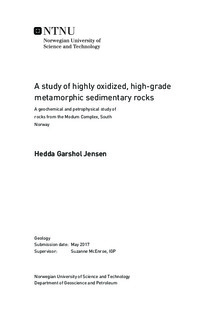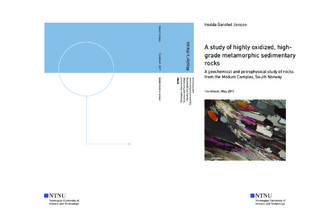| dc.description.abstract | The Modum Complex is a part of the Kongsberg Sector, located west of the Oslo Graben in southern Norway. It is made up of arenaceous, argillaceous and calcareous rocks, in addition to volcanites and intrusives. Regionally, the rocks have been exposed to amphibolite facies metamorphism, and aeromagnetic surveys have shown numerous negative anomalies in the area. The investigated rocks are a part of the Høgås anticline, and are of a chemical composition that has not been investigated commonly in the past.
In order to investigate the rare chemical space and possible sedimentary protoliths of these rocks, varied laboratory work has been done. Microscopy, EPMA and XRF were performed to explore mineralogy and geochemistry, presenting Fe-Mg-rich rocks, low in Al, Na, Ca and K. Using rock chemistry and mineral assemblages, two compositional groups were recognized; one kyanite/sillimanite-bearing group including talc with rare NaAl-substitution, and one amphibole-bearing groups, displaying higher amounts of Ca.
The tourmalines in the amphibole-rocks display higher Ca-content than the tourmalines in the kyanite-rocks, and these are interpreted to be formed in early stages of metamorphism. This reflects that the chemical differences in the rocks are due to differences in the original iron-rich sediments. To find a suitable protolith, the XRF-results are compared to chemical compositions of sedimentary rocks found in various literature. The rocks are possibly derived from a hematite-rich, Al-poor, silty pelite with components of volcanic ash and/or evaporite chemistry. The protoliths are interpreted to be originally oxidized, owing to an oxidizing, alkaline, shallow marine environment with absence of organic carbon.
The magnetic properties were explored by measuring NRM and susceptibility, in addition to temperature dependent susceptibility and demagnetization behavior. These investigations point out titanohematite as the primary remanence carrier. Again, two groups were recognized, displaying higher NRM and susceptibility for the kyanite-bearing rocks, along with higher contents of titanohematite. Demagnetization measurements indicate presence of two oxide phases, possibly owing to nanoscale exsolution lamellae of ilmenite in the titanohematite. | |

